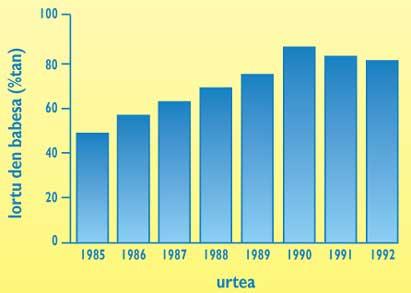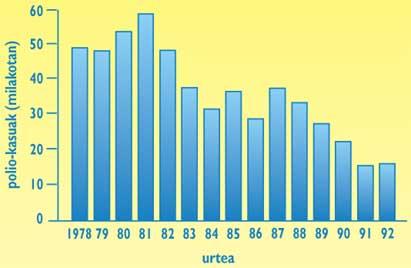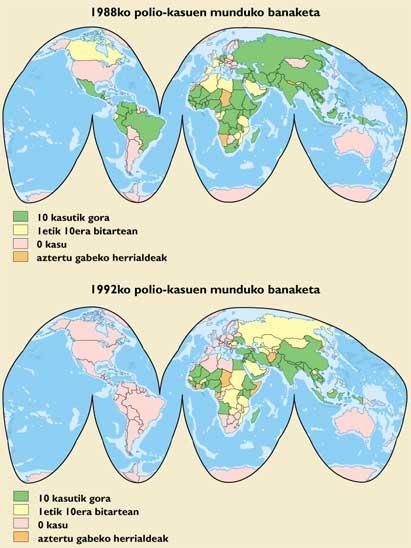Polio: disease to be eradicated
In the last two years in the western hemisphere there have been no patients affected by polio, and in the rest of the territories it is increasingly scarce. H.F., recently responsible for vaccines at WHO. Hull and his collaborators, in a work published in the magazine Lancet, show what is the intention to completely hide polio and in this work I summarize it.

Epidemiological foundations for radication
Most poliovirus infections are symptom-free and in less than 1% paralysis appears. As can be confused with other diseases, the only way to obtain a reliable diagnosis is the detection of spring viruses in the laboratory.
It is, above all, the disease that appears in young children, in 70-90% of cases in children under 3 years. It has to do with the seasons of the year and most cases occur in the warm and humid months of summer. Its incubation time is 4-35 days and is spread through the feces/mouth. In other nonhuman animals, the virus does not appear, but it can remain in the environment for 3 months.
Poliovaccines
In 1955 the inactive Salk poliovaccine (ITP) was created and in 1961 the weakened oral Sabin vaccine (ATA). Each has its advantages and both are used, but it is uncertain that pollution in developing territories would be avoided with ITP.
ATA resembles natural infection and produces immunity in the digestive system and can also move from stool/mouth to other people. However, it presents a complication in a case of 2,500,000 doses, which is polio associated with the vaccine.
High levels of immunization with two or three doses of ATA are achieved in industrialized countries. In tropical regions immunizations range from 70% to 90%.
Because it prevents better transmission of the virus, because it is easy and cheap to take, ATA is the vaccine that WHO has chosen to eradicate.
Radication strategies
Conventional immunization
Since WHO launched an immunization programme in 1974, most states have joined together. 80% of children born worldwide in 1990 have achieved basic immunization against polio, diphtheria, pertussis, tetanus, measles and tuberculosis. The spread of polio virus has decreased considerably and its establishment is possible with the help of other measures. Conventional immunization has been shown to be insufficient for establishment due to the occurrence of polio cases in some states that have reached an immunization greater than 90%. The greatest risk is in the wrong or unimmunized groups. Ethnic minorities, illegal immigrants, itinerant collectivities, born and unregistered children and religious groups against immunization are the most dangerous.
National Immunization Days (INE)
In endemic territories several years will be required. WHO recommends that children under 5 take two doses of ATA vaccine without taking into account the above. The vaccination will take place within two periods of one week, leaving a 4-8 week interval between the two. These campaigns should be carried out in dry and cold seasons, with ease of transport and greater difficulty of polio contamination.
Immunization in case of recurrence
The presence of a polio patient indicates an insufficient level of immunization in the local community. Although other children may already be infected, the WHO advice is to provide a vaccine dose to all children under 5 who are in the area, regardless of the previously ingested doses. Local epidemiology and available means will be taken into account to determine the scope for this.
Immunization for cleaning
There are also places left with low immunization with CIS campaigns, and are polio cases. Since children cannot be taken to health centers, people are preparing to teach how to get vaccinated and vaccinate at home. WHO believes that all children under the age of 5 should be given two doses per month using dry seasons.

Care strategies
According to the WHO, “anyone with flakidic paralysis, including Guillain-Barré syndrome, may have polio; in children under 5 years of age, without other reasons and in any case diagnosed as such at all ages.” Each country must have established the means to inform and act quickly in the following cases: analyze before 7 days from the onset of paralysis, collect and analyze stool samples before 14 days and conduct a detailed follow-up of 60 days.
Current situation and prospects for the year 2000
Before finding vaccines, 600,000 cases of polio paralysis appeared worldwide. Since then the discount has been constant: 15,406 cases in 1992, 52% less than in 1988, but 8% more than in 1991. However, many of the conservation areas are not pit and it is estimated that in 1992 there would be about 140,000 cases. Figure maps show the global distribution of polio cases in 1988 and 1992.
In the western hemisphere the last case appeared in Peru in 1991. In South America, the clean-up immunization campaign was very effective, especially in Colombia and Peru. In Europe, 169 cases were recorded in 1992 (68 of them renounced the immunization campaign in a Dutch religious community). In Africa the situation is very different in different states. Much remains to be done in Asia.
The Polo settlement program will cost $1 billion within 10 years and many States cannot deal with the corresponding part. Developed countries must recognize that radicalization is also for their own benefit. Money is needed to pay wages to workers, for teaching, communications, research, and the creation and maintenance of a network of laboratories, but more than 80% of spending will be needed to produce 10 billion doses of vaccine. WHO and UNICEF want to create vaccine production and distribution workshops in 14 countries.
It is estimated that half or one third of vaccines are wasted for various reasons: the unfinished discharge of multidose vaccine blisters after immunization campaigns and the possible loss of vaccine effectiveness at temperatures above 37ºC. A stable vaccine at 45°C is being investigated for 7 days.
Wars, human conflicts and economic and social changes are obstacles to radicalization. In some warring territories, such as El Salvador, a truce was signed to carry out campaigns of insertion.
If everyone joins together, polio and paralysis that can lead to it may disappear and, as a result, the amount of money currently spent on vaccination campaigns is spent on other health tasks.






